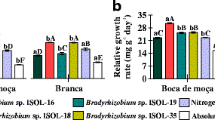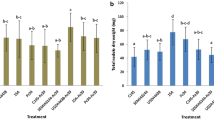Summary
Field experiments were established at three locations in the Dominican Republic to evaluate the response of field beans (Phaseolus vulgaris L. cv. Pompadour) to inoculation with selected strains ofRhizobium phaseoli. A comparison of no-tillage and conventional tillage was included to determine whether modification of rhizosphere temperature and moisture would influence the inoculation response. Yields of inoculated treatments were not statistically difference from controls and ranged from 30–80% of those obtained on N-fertilized plots. Neither tillage systems nor P fertilization influence the response to inoculation. Serological investigations indicated that the applied rhizobial strains nodulated successfully. This host/endophyte combination appears to form an ineffective symbiotic association. Inoculation trials employing indigenous and commercial strains compared with N fertilizer in the greenhouse support the conclusion from the field studies that symbiotic N2 fixation can provide only a fraction of the plant's N requirement.
Similar content being viewed by others
References
Alexander M 1982 Most probable number method for microbial populations.In Methods of Soil Analysis, Part 2: Chemical and Microbiological Properties. Ed A L Page. Agronomy Monograph No. 9, Second Edition. ASA Madison, Wisconsin, USA.
de Almeida D L, Pessanha G G and Penteado A 1973 Efeito da Calagem e da Adubacao Fosfatado e nitrogenado na nodulucao e producao do feijoeiro (Phaseolus vulgaris) [Effects of liming, phosphorus and nitrogen fertilization on nodulation and yield of bean (Phaseolus vulgaris)]. Pesq. Agropec. Bras. 8, 127–130.
Blevins R L and Thomas G W 1981 Soil adaptabitity for no-tillage.In No-Tillage Research: Research Reports and Reviews. Eds. R E Phillips, G W Thomas and R L Blegins Univ. of Ky. Agric. Exp. Stn. Lexington, KY, USA.
Bradstreet R B 1965 The Kjeldahl Method for Organic Nitrogen. Academic Press Inc. New York.
Cassman K G, Whitney A S and Fox R L 1981 Phosphorus requirements of cowpea and soybean as effected by mode of nitrogen nutrition. Agron. J. 73, 17–22.
Dobereiner J and Campelo A B 1977 Importance of legumes and their contribution to tropical agriculture.In A Treatise on Dinitrogen Fixation Section IV: Agronomy and Ecology. Eds. R W F Hardy and A H Gibson, Wiley, New York, NY, USA.
Duque F F, Salles L T G, Pereira J C and Dobereiner J 1982 Influence of plant genotype on some parameters of nitrogen fixation inPhaseolus vulgaris In Biological Nitrogen Fixation Technology for Tropical Agriculture. Eds. P H Graham and S C Harris. CIAT Cali, Columbia.
Eriksen F I and Whitney A S 1984 Effects of solar radiation regime on growth and N2-fixation of soybean, cowpea, and bushbean. Agron. J. 76, 529–535.
Gibson A H 1977 Factors in the physical and biological environment affecting nodulation and nitrogen fixation by legumes. Plant and Soil Special Vol. 139–152.
Gibson A H 1977 The influence of the environment and managerial practice on the legume-Rhizobium symbiosis.In A Treatise on Dinitrogen Fixation Section IV: Agronomy and Ecology. Eds. R W F Hardy and A H Gibson, Wiley, New York NY, USA.
Graham P H 1982 Research on biological nitrogen fixation in the international agricultural research centers.In Biological Nitrogen Fixation Technology for Tropical Agriculture. Eds. P H Graham and S C Harris, CIAT, Cali, Columbia.
Graham P H, Apolitano C, Ferrer-Cerrato R, Halliday J, Lepiz R, Mendey O, Rios R, Saito S and Viteri S 1982 The international bean inoculation trial (IBIT): Results for the 1978–1979 Trial.In Biological Nitrogen Fixation Technology for Tropical Agriculture. Eds. P H Graham and S C Harris. CIAT, Cali, Columbia.
Graham P H and Halliday J 1977 Inoculation and nitrogen fixation in the genus phaseolus.In Exploiting the legume-Rhizobium symbiosis in tropical agriculture. Ed. J M Vincent Univ. of Hawaii Coll. Trop. Agric. Misc. Publ. 145, 313–334.
Graham P H and Rosas J C 1977 Growth and development of indeterminant bush and climbing cultivars ofPhaseolus vulgaris L. inoculated with Rhizobium. J. Agric. Sci. Cambridge. 88, 503–508.
Harris S C 1982 Internationally sponsored development of biological nitrogen fixation technology.In Biological Nitrogen Fixation Technology for Tropical Agriculture. Eds P H Graham and S C Harris. CIAT, Cali, Columbia.
Hewitt E J 1966 Sand and water culture methods used in the study of plant nutrition. Revised 2nd edition Commonwealth Bureau of Horticulture and Plantation Crops., East Malling Techn. Comm. No. 22.
Hoagland D R and Arnon D I 1950 The water culture method for growing plants without soil. Calif. Agric. Exp. Stn. Cir. 347.
Mahler R L and Wollum A G 1980 Influence of water potential on the survival of rhizobia in a Goldsboro loamy sand. Soil Sci. Soc. Am. J. 44, 988–992.
Marshall K C 1964 Survival of root nodule bacterial in dry soils exposed to high temperatures. Austr. J. Agric. Res. 15, 273–281.
Munns D N 1977 Mineral nutrition and the legume symbiosis.In A Treatise on Dinitrogen Fixation Section IV: Agronomy and Ecology. Eds W F Hardy and A H Gibson. Wiley, New York, NY, USA. p. 527.
Parker C A, Trinick J J and Chatel D L 1977 Rhizobia as soil and rhizosphere inhabitants.In A Treatise and Dinitrogen Fixation Section IV: Agronomy and Ecology. Eds. R W F Hardy and A H Gibson.
Pate J S 1961 Temperature characteristics of bacterial variation in legume symbiosis. Nature 192, 637.
Pena-Cabriales J J and Alexander M 1979 Survival of Rhizobium in soil undergoing drying. Soil Sci. Soc. Am. J. 962–966.
Philpotts H R 1967 Use of straw mulch for improved nodulation with high temperature in Cowpeas. J. Exptl. Agric. Anim. Husb. 7, 372–376.
Quintero J J, Gonzales S M, Calzado C, Castillo M A and Pena M 1983 Effecto da la inoculacion de frijol en zonas de temporal en Durango. Turrialba 33, 303–309.
Schwinghammer E A and Dudman W F 1980 Methods for identifying strains of diazotrophs.In Methods for evaluating biological nitrogen fixation. Ed F J Bergersen. John Wiley and Sons Inc. New York.
Sprent J I 1971 The effects of water stress on nitrogen fixation in root nodules. Plant and Soil Special Vol. 225–228.
Taylor J D, Day J M and Dudley C L 1983 The effect of Rhizobium inoculation and nitrogen fertilizer on nitrogen fixation and seed yield of dry beans (Phaseolus vulgaris) Ann. Appl. Biol. 103, 419–429.
Vincent J E and Smith M S 1982 Evaluation of inoculant viability on commercially grown legume seed. Agron. J. 74, 921–923.
Waters L, Graham P H, Breen P J and Mack H J 1980 The effect of rice hull mulch on growth, carbohydrate content and nitrogen fixation inPhaseolus vulgaris L. Hortic. Sci. 15, 138–140.
Weaver R W and Frederick L R 1972 A new technique for most probable number counts of Rhizobia. Plant and Soil 36, 219–222.
Author information
Authors and Affiliations
Rights and permissions
About this article
Cite this article
Huntington, T.G., Smith, M.S., Thomas, G.W. et al. Response ofPhaseolus vulgaris to inoculation withRhizobium phaseoli under two tillage systems in the dominican republic. Plant Soil 95, 77–85 (1986). https://doi.org/10.1007/BF02378854
Received:
Revised:
Issue Date:
DOI: https://doi.org/10.1007/BF02378854




